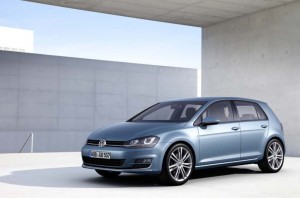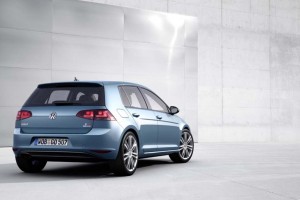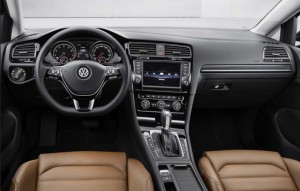Volkswagen has a lot riding on the seventh-generation Golf. The all-new version will have some big tire tracks to fill considering the Golf is the German maker’s global best-seller – but one facing increasingly tough competition at home and abroad.
The public – and most media – will get a first close-up look at the 2013 VW Golf at the upcoming Paris Motor Show, but the maker gave a few select journalists a sneak peek this week during a preview in Berlin.
No surprise, the maker declared, “This seventh-generation version of one of the world’s most popular cars is striking in that it offers more features, even better safety, and more performance than the outgoing vehicle, while breaking the cycle of being heavier than its predecessor.”
The new Golf is 2.2-inches longer than the Gen-6 model, 0.5-inches wider and 0.8-inches lower.
The Gen-7 Golf also follows an increasingly common pattern among manufacturers to shed weight wherever possible – mass being the enemy of both mileage and performance, as any good automotive engineer will explain. Considering the diminutive size of the Golf, losing 220 pounds compared to the outgoing model is no small feat.
One reason is the increased use of high-strength steel, which has gone from 6% to 28% of the total steel used in the 2013 VW Golf.
But also give credit to the use of the new MQB platform Volkswagen has been quietly developing. It is one of five “architectures” that will eventually be shared by virtually every vehicle in the Volkswagen empire, from lowly Skodas and Seats to top-line Lamborghinis, Porsches and Bentleys.
The MQB will be the most important of those platforms and could eventually account for as many as 5 million vehicles a year, according to VW Group executives. What’s equally significant is that to get there the maker has designed the architecture with maximum flexibility in mind. That means MQB vehicles can grow longer or shorter, wide, narrower, adopt rear-drive, front or all-wheel-drive.
At the Berlin preview, VW focused solely on the European-spec Golf – shown with a 1.4-liter turbocharged inline-four.
It remains to be seen whether that package will be brought to the States, though considering the general downsizing of powertrains that is a distinct possibility. Reports out of both the U.S. and Europe have focused on a 1.8-liter turbo package that could replace the current American 2.5-liter five-cylinder powerplant.
Meanwhile, don’t be surprised to see a diesel make the jump over the Atlantic, as well. VW officials noted this week that they’re now equipping over 25% of their U.S. Passats with oil-burner technology and believe that could soon reach 30% or more.
With U.S. fuel prices now nudging $4 again, it’s all but certain VW could find buyers for a 140-horsepower 1.4-liter turbodiesel Golf that in Euro-spec delivers 49 mpg combined. The smaller base diesel, at 105-hp, would likely be seen as too anemic, however, even at a combined 62 mpg.



